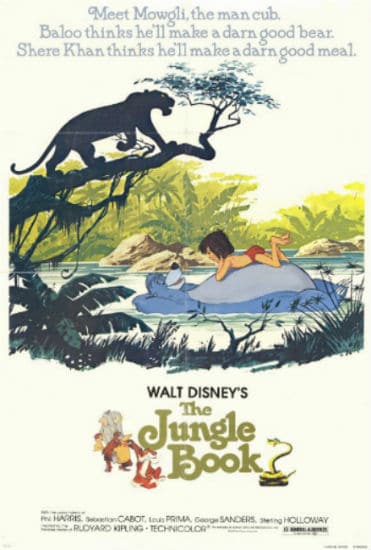
Welcome to Revisiting Disney! Today, we’re looking at that movie which taught us all the bare necessities of life, The Jungle Book! Like last time, I have labeled each category so if you want to skip to the parts that interest you most, feel free. And, of course, if you have any thoughts, burning or otherwise, please share in the comments!
BACKGROUND OF THE JUNGLE BOOK
The Jungle Book was released on October 18th, 1967 and seems to be one of the most beloved Disney films ever made. It was voted as Number 19 in a UK news channels, “Greatest Family Films” list, and it also placed 7th in the UK’s Ultimate Film list.
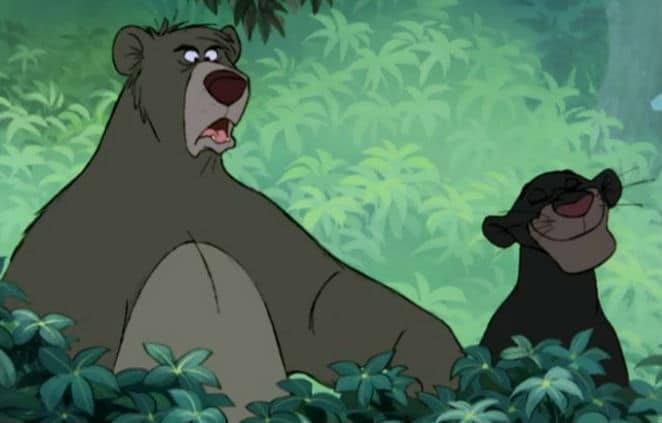
Photo: Disney
The Jungle Book is also the first time in a Disney film where the opening credits include the vocal talents as well as the crew. In The Jungle Book, Walt was more actively involved than he had been in the past because he had a clear vision for the film, a fun vision. In special features, Walt reportedly told his animators to “just have fun” with it. By all accounts, they did, and we have a ton of fun watching it today too.
This was the last film that Walt Disney was involved in because, in late 1966, he discovered that he had advanced lung cancer. He underwent surgery but, on December 15th, 1966 at the age of 65, Walt Disney passed away in his hospital room. The film wasn’t quite done, but the animators finished it and it can be assumed that he would have been proud of the end result.
RELATED | Walt Before Mickey Film Review
I want to quickly look at Walt’s early history. Walt Disney was born in Chicago on December 5th, 1901 (Happy Birthday Walt Disney!). He was the second youngest of four, and five years later his family moved to Marceline, Missouri. According to film historian Christopher Finch, it was in Missouri that Walt started to draw, even attending some art classes.
In 1917, the family moved back to Chicago, though Walt stayed in Kansas City to finish his school year before heading to Chicago. When WWI broke out, Walt’s mother allowed him to say he was 17, not 16, to become a Red Cross ambulance driver.
In 1919, when he returned to the States, Walt moved to Kansas City where he became friends with Ub Iwerks. The two men started working on cartoons together, creating shorts that were technologically advanced.
With one of Walt’s first creations, Oswald the Rabbit, there was a copyright issue and several members of Disney’s staff were hired away from him. Disney was hurt by the Oswald the Rabbit Incident, but after this setback, Iwerks and Disney developed a series of Silly Symphonies and a squeaky-voiced cartoon mouse. The rest, as they say, is history.
The Jungle Book is also special in that it was also the last film to feature Verna Felton (of Sleeping Beauty and Dumbo fame).
MUSIC
The original version of The Jungle Book was written by Bill Peet, who had written The Sword in the Stone and 101 Dalmatians. Peet based his adaptation very strongly in the source material, but according to the Disney Studio in numerous behind the scenes specials, Walt felt that Peet’s story was too dark, so the entire thing was scrapped. Check out the Source Material Section for more information on that.
When Bill Peet’s story had been scrapped, most of the music written by Terry Gilkyson was also removed, but the animators and rest of the staff pleaded for one song to be kept. That one song would later be nominated for an Oscar in the Best Music, Original Song category of the 1968 Academy Awards, “The Bare Necessities.” Imagine the world where that song wasn’t a part of our collective childhoods…
The other songs were written by my favorite songwriting sibling team, the Sherman Brothers. In the Making Of Feature, Richard Sherman remembers that Walt liked the songs to serve a point, so often had the brothers in story sessions, so they could know what their songs were doing, not just filling in a blank space in the plot.
The score was arranged by George Bruns, who had done several other films for Disney (Sleeping Beauty and The Sword in the Stone, among others). Richard Sherman talks about Bruns’ talent in arranging the score, because all the songs the Brothers wrote have been woven into the score in some way, creating a more cohesive story. I hadn’t thought about that, until I heard him say that, and then it all made sense.
The background music is good at staying in the background. This seems obvious, but it is able to pull the story together without overwhelming it. I love the work Bruns does because it always complements the animation in ways that can’t have been easy to time. It sounds so effortless, and I love it.
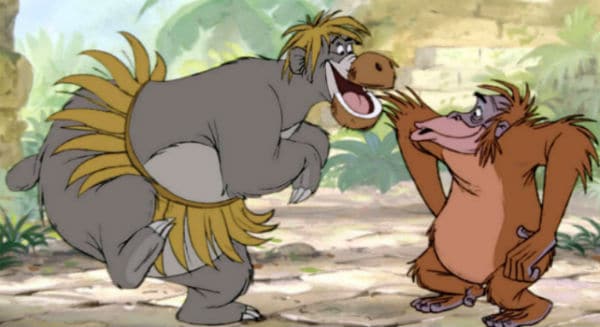
Photo: Disney
The song “I Wanna Be Like You,” written by the Sherman Brothers, was in many ways improvised by Louie Prima and his band. According to the animators, it was so jazzy and wild that they had to tone it down. Louie is supposed to have said, however, that he had a wonderful time making the film.
When it came time for the Baloo/Louie duet, they had a set response to Louie’s part since Phil Harris couldn’t attend the recording. However, Harris didn’t like the lines he was given, so he improvised his responses to the recording of Louie Prima scatting. That’s the version that we have in the film today, which is awesome.
ANIMATION
The Directing Animators were, again, from the Nine Old Men and the team was made up of Milt Kahl, Ollie Johnston, Frank Thomas, and John Lounsbery, with Wolfgang Reitherman serving as the director and Eric Larson working as an animator.
The backgrounds are beautiful and lush, and any of the scenes could be paused and hung on a wall. According to IMDB, the Disney animators visited the jungles of India to make the backgrounds more accurate, as well as studying the wildlife.
Like with Bambi, the animators studied the movements of the animals they were animating, looking at live footage and copying those characteristics. This is particularly easy to see in the movements of Bagheera, Shere Khan, Kaa, and Baloo.
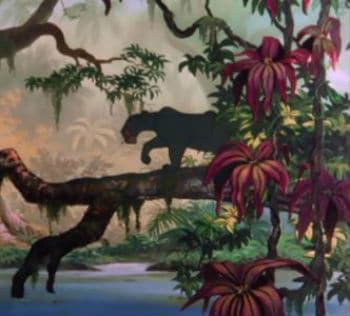
Photo: Disney
The characters were also very inspired by their voice actors, so King Louie is heavily influenced by Louis Prima, Bagheera by Sebastian Cabot, Shere Khan by George Sanders and Baloo by Phil Harris. This worked out because the film was more character driven than plot driven, as the animators said.
When you think of this film, really, it’s the music and the characters that come to your mind first, rather than the plot itself. The animators had been, Thomas says, told how important story was when working on other films, so when they were told that the story was secondary to the characters in The Jungle Book, they were concerned. Walt promised them it would be okay (Thomas 1992:107).
Ollie Johnston said that the film wasn’t gelling together well until Phil Harris took the lines for Baloo and read them in his own language. At that point, things just started to come together. This just shows, again, how much these beautifully animated characters affected the story.
THE PLOT
Narrated by Bagheera the panther, our story opens with Bagheera hearing the cries of a human baby, or man-cub, and deciding he needs to be taken care of. Bagheera ends up taking him to the wolves where he was adopted by a family and grew to be ten years old.
When Mowgli is ten, Shere Khan the tiger who hates all mankind, returns to the jungle. The wolves are afraid that he will try to kill Mowgli and know that they can’t save him against Shere Khan, so they determine that Mowgli has to go back to the man village. Bagheera volunteers to take him, and that starts the adventure in earnest. Mowgli is reluctant to leave the jungle and spends a lot of time trying to convince Bagheera to let him stay in the jungle.
On their journey, Bagheera and Mowgli meet many strange characters. They have a run-in with Kaa the python, who wants to eat the poor boy, meet up with the Jungle Patrol, led by Colonial Hathi, and meet Baloo who Bagheera calls a “shiftless jungle bum.”
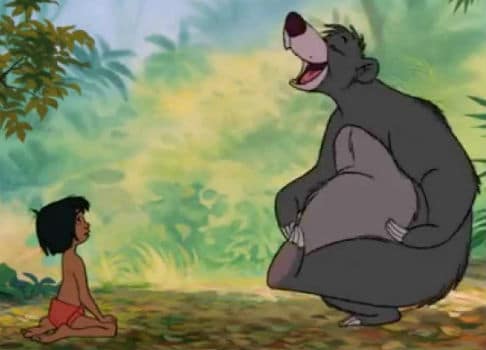
Photo: Disney
Mowgli decides to stay with Baloo in the jungle, and Baloo plans to adopt him. They sing the amazingly catchy “Bare Necessities” together before Mowgli is captured by the monkeys, who bring him to their king, Louie, who wants to be human. To gain that end, he wants Mowgli to teach him how to make fire.
This leads to another amazing number, “I Wanna Be Like You,” which has been adapted for numerous groups (my honor choir sang an arrangement of this song at Jazz Fest in high school). Baloo and Bagheera infiltrate the ruins where the monkeys live to save Mowgli, and Bagheera convinces Baloo that Mowgli will be safer in the man village.
Feeling betrayed by his “Papa Bear,” Mowgli runs off into the jungle alone. Baloo and Bagheera set out to find him before Shere Khan does, but the wily tiger overhears Bagheera asking the Jungle Patrol for assistance and sets off to find the little lost kid.
Kaa, the wily snake, finds Mowgli and after another catchy (yet vaguely sinister) musical number is about to digest our young hero. However, Shere Khan comes knocking, asking Kaa to keep an eye out, which gives Mowgli a chance to get away.
Mowgli is now hurt, sad, and feeling betrayed by everyone. He finds himself near a group of buzzards patterned after the Beatles who decide that he needs a friend and adopts him. Of course, at this moment Shere Khan shows up to kill Mowgli. Luckily for the fearless kid, Baloo, and the buzzards help him get away and use fire from a nearby lightening strike to scare away Shere Khan.

Photo: Disney
In the fight, however, it seems that Baloo has died defending his friend. Bagheera, Mowgli, and the buzzards mourn, but it turns out that Baloo was just knocked out. Everyone is excited and since Shere Khan is no longer a threat, Mowgli can stay in the jungle.
At that moment, a young girl appears to gather water near the village, and as Mowgli has never seen another human before, he’s intrigued. Of course, she sees him and, when she smiles at him, he ends up following her home to the village. This happens to the delight of the girl and Bagheera, and the chagrin of Baloo. In the end, Bagheera convinces Baloo that Mowgli is where he belongs and, singing all the way, the two go back to where they belong.
SOURCE MATERIAL
The Jungle Book is based on two collections of short stories by (Joseph) Rudyard Kipling, though it’s important to note that they were very loosely based on the “Mowgli” stories. The plot of The Jungle Book as we know it went through two very different stages. Bill Peet’s original story ideas were very much rooted in Kipling’s work, but according to the Disney Studio in numerous behind the scenes specials, Walt felt that Peet’s story was too dark, including some plot points that the Studio would use in their live action film in 1994. Peet and Walt disagreed, and Bill Peet left the Studio.
When Walt hired his new story guys, Larry Clemmons, Ralph Wright, Ken Anderson, and Vance Gerry, Larry Clemmons remembers that Walt handed him a copy of the book and said, “The first thing I want you to do is not to read it” (Thomas 1992:107).
On the back of the book, the description of Mowgli is this: “The orphan baby raised by the wolves, taught by Baloo, trained by Bagheera and Kaa. The sorcerer who knows the ways of the jungle and speaks the language of the wild” (Kipling 1988).
Parts of the story are there; the threat of Shere Khan being the thing that causes the wolves to want Mowgli to leave the jungle and Shere Khan being driven away by fire, but other things are missing from the film. Kaa is not a villain, but someone that Baloo and Bagheera go to for help freeing Mowgli from the apes, or the Bandar-log.
Mowgli is taught jungle lore by Baloo, who teaches all the young wolves, and by Bagheera and Kaa. In the beginning of the book, Mowgli needs two members of the Pack to speak for him so he can stay with the wolves, and Baloo steps forward. Bagheera offers a fresh kill of his as his pledge of sponsorship.
There are instances of wolf pack politics, which were very interesting to me. Shere Khan and his lackey, Tabagui the jackal, begin to cause dissension in the pack, leading to Mowgli and some wolves to have to fight to defend the honor of the pack. Another difference is that, in the end, Mowgli is exiled from the man village, because he has too much of the jungle in him. Of course, he also calls his animal friends to help him destroy the village, but that’s not really family-friendly.
There were also additional stories in the books, my favorite being the story of “Rikki-Tikki-Tavi.” “Rikki-Tikki-Tavi” is the story of a mongoose who adopts a family and then protects them from the cobras and other deadly snakes who threaten them, particularly the little boy, Teddy.
The 1960’s
According to some historians, many Americans thought that the 1960’s would be the beginning of a golden age, particularly with the election of JFK and his inauguration in 1961. However, by the end of the decade, America was a bit of a mess. In 1964, the United States entered the war in Vietnam, and the draft began.
The Vietnam War divided the nation in a lot of ways. There were protests, people fleeing the country to not be drafted, and others who supported the War and what it was being fought for, to protect America from communism.
1964 was also the year that President Johnson passed the Civil Rights Act, which made discrimination in public, separate water fountains, counters, etc, illegal. I’m way oversimplifying it, but that was the basic gist.
Of course, this didn’t really solve the problem; just because a law is on the books, doesn’t mean it will be enforced. More militant civil rights leaders like Malcolm X came into prominence in the 60’s, offering a different path than Martin Luther King Jr (who was assassinated on April 4th, 1968).
While the Civil Rights Movement was happening, there was also a feminist movement. Women began to demand equal rights as men, and, like the African Americans in the Civil Rights Movement were often frustrated when reforms happened too slowly or only on paper. More militant groups were formed in the feminist movement as well.
The final major event in the 60’s was the counter-cultural “hippie movement,” which was the result of people fleeing the conflicts and anger found in everyday life. The phrase “peace, love and rock ‘n’roll” can be seen as a response to the turmoil of the 60’s; that’s really all we need to make things better, peace, love and rock’n’roll. The television show “American Dreams” was, if I remember correctly, actually quite a great portrayal of life in the 60’s.
Things really began to fall apart in 1968. The assassinations of Martin Luther King Jr and Robert Kennedy (called by the History Channel “the two most visible leftists in American politics”), violence at the Democratic National Convention, urban riots, and antiwar protests stand in stark contrast to the 1969 Woodstock Music Festival.
Overall, the 1960’s were a decade of rebellion against practices that restricts groups of people from their basic rights; they were also a time of violence and anger and a time that emphasized peace and love.
The 60’s really set the stage for our country’s future, and hopefully we can all look at the lessons and hard-fought battles to remember that we have come a long way since the 50’s, but in many ways we still have a long way to go.
LESSONS LEARNED
From The Jungle Book, I learned what the bare necessities are. But seriously, the song reminds me that sometimes a simple life is best. We don’t need all sorts of fancy things, and sometimes worrying is useless. We can’t do anything anyway, so we might as well just do our best and go with the flow. In today’s fast-paced world, that’s a reminder that I appreciate.
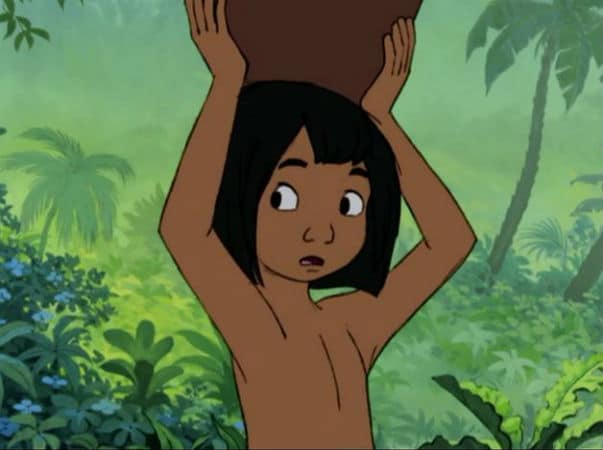
Photo: Disney
I also was reminded that there is no greater sacrifice than to die for your friends. This is what Bagheera says when they think Baloo has died to save Mowgli. To love people enough to be willing to die for them, or fight a very angry tiger for them is nothing to sneeze at. I like to think I would fight off a tiger for my family and friends, but I suppose you never know until it happens.
DOES IT HOLD UP?
The Jungle Book is not only the last film to have the personal touch of Walt Disney, it was also a commercial success when it was released and has remained a very popular film. Most of us grew up knowing the characters and the songs, and it’s a film that is just as catchy when you’re an adult as it is when you’re a kid. It’s one of the most beloved Disney films, for a good reason. Trust in me, it’s well worth the watch.
For next week: The Aristocats
If you enjoyed this post and the others in the Revisiting Disney series, and have found yourself wishing that you could find them all in one convenient and bound book with eight extra essays, there is an option for you! Check out A Journey Through Disney: My Look Back Through Disney Canon, now available on Amazon as both a Kindle book ($4.99) and a paperback ($11.99).
OTHER SOURCES:
https://thewaltdisneycompany.com/about-disney/disney-history
http://www.imdb.com
http://studioservices.go.com/disneystudios/history.html
Bailey, Adrian. Walt Disney’s World of Fantasy. Everest House Publishers. New York, New York. 1982.
Finch, Christopher. The Art of Walt Disney: From Mickey Mouse to the Magic Kingdom. Harry N. Abrams, Inc. New York, New York. 1975.
Kipling, Rudyard. The Jungle Book. A Tor Book, Tom Doherty Associates, New York, New York. 1988.
Sale, Roger. Fairy Tales and After: From Snow White to E.B. White. Harvard University Press. Cambridge, MA, 1978.
Tatar, Maria. The Annotated Classic Fairy Tales. W.W. Norton and Company. New York and London, 2002.
Thomas, Frank. Disney’s Art of Animation From Mickey Mouse to Hercules. Hyperion. New York, New York. 1992.
Wright, Gordon. The Ordeal of Total War: 1939-1945. Harper Torchbooks, Harper & Row. New York, Hagerstown, San Francisco, and London, 1968.
ARE YOU A ROMANCE FAN? FOLLOW THE SILVER PETTICOAT REVIEW:
 Our romance-themed entertainment site is on a mission to help you find the best period dramas, romance movies, TV shows, and books. Other topics include Jane Austen, Classic Hollywood, TV Couples, Fairy Tales, Romantic Living, Romanticism, and more. We’re damsels not in distress fighting for the all-new optimistic Romantic Revolution. Join us and subscribe. For more information, see our About, Old-Fashioned Romance 101, Modern Romanticism 101, and Romantic Living 101.
Our romance-themed entertainment site is on a mission to help you find the best period dramas, romance movies, TV shows, and books. Other topics include Jane Austen, Classic Hollywood, TV Couples, Fairy Tales, Romantic Living, Romanticism, and more. We’re damsels not in distress fighting for the all-new optimistic Romantic Revolution. Join us and subscribe. For more information, see our About, Old-Fashioned Romance 101, Modern Romanticism 101, and Romantic Living 101.

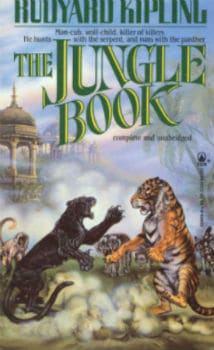
a lot of interesting scene … worth a watch …. you can never be someone or something you are not